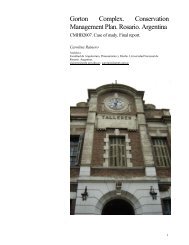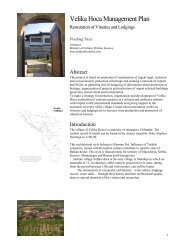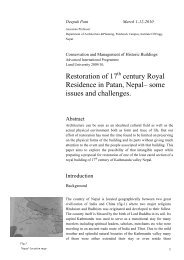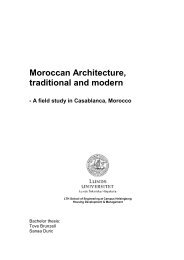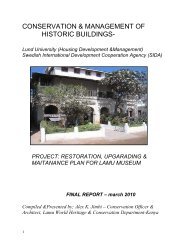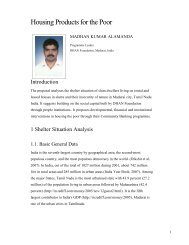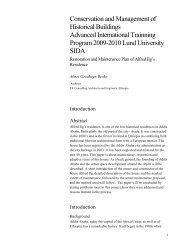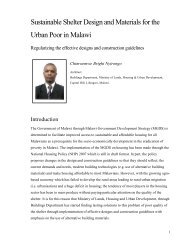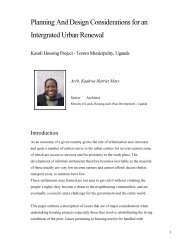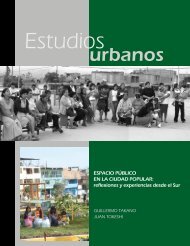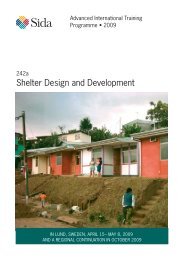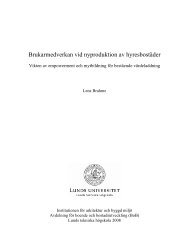Management Plan for the Barasoain Church Historical ... - HDM
Management Plan for the Barasoain Church Historical ... - HDM
Management Plan for the Barasoain Church Historical ... - HDM
You also want an ePaper? Increase the reach of your titles
YUMPU automatically turns print PDFs into web optimized ePapers that Google loves.
Old picture of <strong>Barasoain</strong> <strong>Church</strong><br />
<strong>Church</strong> main altar<br />
<strong>Management</strong> <strong>Plan</strong> <strong>for</strong> <strong>the</strong> <strong>Barasoain</strong> <strong>Church</strong> <strong>Historical</strong> Landmark<br />
They not only used <strong>the</strong> sword as part of controlling <strong>the</strong> country but<br />
also used <strong>the</strong> cross. The Spaniards <strong>for</strong>ced <strong>the</strong> Filipinos to construct<br />
churches as a place of worship. In <strong>the</strong> entire Philippines, <strong>the</strong>re are<br />
countless churches built during <strong>the</strong> Spanish period; a product of<br />
hardship and perseverance of many Filipinos. These churches served<br />
not only as a place of worship but also as a place of refuge during<br />
trying times.<br />
One of <strong>the</strong> more significant churches in <strong>the</strong> country is <strong>the</strong> <strong>Barasoain</strong><br />
<strong>Church</strong>. Located in Malolos, Bulacan, this church has contributed in<br />
<strong>the</strong> struggle <strong>for</strong> independence. <strong>Barasoain</strong> was a visita of Malolos from<br />
which it separated in 1859. The first parish priest, Fr. Francisco<br />
Arriola was appointed on June 1, 1859. He built its convent. A small<br />
ermita was constructed during <strong>the</strong> time of Fr. Melchor Fernandez in<br />
1816, which served as a temporary parish church. He was <strong>the</strong> priest of<br />
Malolos from 1816-1840. One of <strong>the</strong> existing bells in <strong>the</strong> church,<br />
dated 1870, was installed by Fr. Emeterio Ruperez, which was<br />
donated by <strong>the</strong> principalia of Malolos. It was dedicated to Our Lady of<br />
Carmel of <strong>Barasoain</strong>. The temporary chapel was replaced with a hewn<br />
stone church by Fr. Francisco Royo in 1871 and 1878 but was<br />
destroyed by fire later on. What was left was one of <strong>the</strong> bells that were<br />
installed by Fr. Royo on February 30, 1873 which was dedicated to St.<br />
Francis Xavier. During <strong>the</strong> term of Fr. Juan Giron, <strong>the</strong> chapel of <strong>the</strong><br />
cemetery was used until it was also destroyed during an earthquake of<br />
1880. He <strong>the</strong>n built a temporary chapel made of nipa and bamboo,<br />
however, it was burned down in 1884 during <strong>the</strong> solemn celebrations<br />
of <strong>the</strong> feast of Our Lady of Carmel. In 1885, Fr. Giron hired a<br />
contractor and started <strong>the</strong> construction of a massive church made of<br />
bricks and masonry. The church was completed under <strong>the</strong> supervision<br />
of Fr. Giron. However <strong>the</strong>re was no specific date of its completion.<br />
Some historian said that “at <strong>the</strong> time it was completed, <strong>the</strong> pockets of<br />
Fr. Giron were drained”, he might have put every penny <strong>for</strong> <strong>the</strong><br />
construction of <strong>the</strong> church. The construction of <strong>the</strong> tower and <strong>the</strong><br />
restoration of <strong>the</strong> convent started during <strong>the</strong> term of Fr. Martin<br />
Arconada in 1889. There were three bells installed in 1897. One of<br />
<strong>the</strong>m is dedicated to St. Martin and was donated by Fr. Arconada. The<br />
convent undertook ano<strong>the</strong>r restoration in 1894 by Fr. Miguel Vera.<br />
The <strong>Barasoain</strong> <strong>Church</strong> played a major role in <strong>the</strong> history of <strong>the</strong><br />
Philippines. Three important episodes in <strong>the</strong> history of <strong>the</strong> Philippines<br />
took place <strong>the</strong>re. After <strong>the</strong> declaration of <strong>the</strong> Philippine independence<br />
in Kawit, Cavite in June 12, 1898, Aguinaldo transferred his<br />
government to Malolos, Bulacan. The <strong>Barasoain</strong> <strong>Church</strong> became <strong>the</strong><br />
venue <strong>for</strong> <strong>the</strong> inauguration of <strong>the</strong> First Philippine Congress on<br />
September 15, 1898, <strong>for</strong> <strong>the</strong> drafting of <strong>the</strong> Malolos Constitution on<br />
September 29, 1898 to January 21, 1899 and <strong>for</strong> <strong>the</strong> inauguration of<br />
<strong>the</strong> First Philippine Republic on January 23, 1899. These events count<br />
among <strong>the</strong> proudest moments in <strong>the</strong> struggle of Filipinos <strong>for</strong> self-rule.<br />
<strong>Church</strong> two side altars<br />
In recent years, <strong>the</strong> buildings have undergone thorough restoration<br />
under <strong>the</strong> supervision of <strong>the</strong> National <strong>Historical</strong> Institute. Because of<br />
<strong>the</strong> significant events that took place in <strong>the</strong> said church and its



